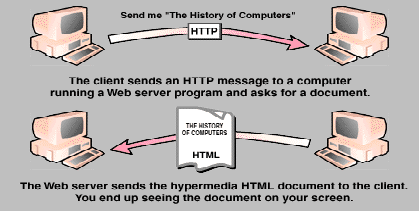


Web software is designed around a distributed client-server architecture. A Web client (often called a Web browser) is a program which can send requests for documents to any Web server. A Web server is a program that, upon receipt of a request, sends the document requested (or an error message if appropriate) back to the requesting client. Using a distributed architecture means that a client program may be running on a completely separate machine from that of the server, possibly in another room or even in another country. Because the task of document storage is left to the server and the task of document presentation is left to the client, each program can concentrate on those duties and progress independently of each other.
For Example:

Client Server Architecture from Entering the World Wide Web - A Guide to Cyberspace.
Future Web servers will include encryption and client authentication abilities - they will be able to send and receive secure data and be more selective as to which clients receive information.
The language that Web clients and servers use to communicate with each other is called the HyperText Transfer Protocol (HTTP). All Web clients and servers must be able to speak HTTP in order to send and receive hypermedia documents. For this reason, Web servers are often called HTTP servers.
The standard language the Web uses for creating and recognizing hypermedia documents is the Hypertext Markup Language (HTML). It is loosely related to, but technically not a subset of, the Standard Generalized Markup Language (SGML), a method of representing document formatting languages. Languages such as HTML which follow the SGML format allow document writers to separate information from document presentation - that is, documents containing the same information can be presented in a number of different ways. Users have the option of controlling visual elements such as fonts, font size and paragraph spacing without changing the original information.
HTML is widely praised for its ease of use. Web documents are
typically written in HTML and are usually named with the suffix ".html".
HTML documents are nothing more than standard 7-bit ASCII files with
formatting codes that contain information about layout (text styles,
document titles, paragraphs, lists) and hyperlinks.
Free conversion software is available for translating documents from many other formats into HTML. Filters exist that can convert files in RTF (Rich Text Format), WordPerfect and FrameMaker as well as man pages, mail archives, and text-only documents.
Electronic Commerce on the Internet - WWW (World Wide Web)
- the "Glossy Brochure"
Rodney Campbell [Rodney.Campbell@Telstra.com.au]
(c)
Copyright 1995 Telstra Corporation.
Last modified: Tue May 16 20:05:13 1995